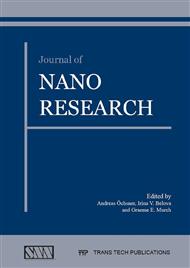[1]
K. Nowakowska-Langiera, R. Chodun, R. Nietubyca, R. Minikayevc, K. Zdunek, Dependence of the specific features of two PAPVD methods: Impulse Plasma Deposition (IPD) and Pulsed Magnetron Sputtering (PMS) on the structure of Fe–Cu alloy layers, Appl. Surf. Sci. 275 (2013).
DOI: 10.1016/j.apsusc.2013.01.190
Google Scholar
[2]
K. Sumiyama and Y. Nakamura, Magnetic properties of metastable crystalline and amorphous Fe alloys produced by RF sputtering, J. Magn Magn Mater. 35 (1983) 219-220.
DOI: 10.1016/0304-8853(83)90500-0
Google Scholar
[3]
A. Hernando and P. Crespo, Magnetic properties of mechanically alloyed Fe-Cu, J Magn Magn Mater. 124 (1993) 5-8.
Google Scholar
[4]
M. Mojtahedi, M. Goodarzi, M.R. Aboutalebi, M. Ghaffari, V. Soleimanian, Investigation on the formation of Cu–Fe nano crystalline super-saturated solid solution developed by mechanical alloying, J. Alloys Compd. 550 (2013) 380–388.
DOI: 10.1016/j.jallcom.2012.10.112
Google Scholar
[5]
Liang-Cai Ma, Jian-Min Zhang, Ke-Wei Xu, Magnetic and electronic properties of Fe/Cu multilayered nanowires: A first-principles investigation, Physica E. 50 (2013) 1–5.
DOI: 10.1016/j.physe.2013.02.020
Google Scholar
[6]
L.T. Kong, B.X. Liu, Distinct magnetic states of metastable fcc structured Fe and Fe–Cu alloys studied by ab initio calculations, Journal of Alloys and Compounds. 414 (2006) 36–41.
DOI: 10.1016/j.jallcom.2005.07.032
Google Scholar
[7]
R. Lardé, Étude d'alliages granulaires Cu-Fe-Co : corrélation microstructure-comportements magnétiques propriétés magnétorésistives, PhD thesis, Rouen, France, (2005).
Google Scholar
[8]
Y. Ueda, S. Ikeda, Y. Mori, H. Zaman, Magnetoresistance and magnetism in Fe-Cu alloys produced by electrodeposition and mechanical alloying methods, Mater. Sci. Eng., A. 217/218 (1996) 371-37.
DOI: 10.1016/s0921-5093(96)10332-4
Google Scholar
[9]
L.M. Socolovsky, F.H. Sanchez, Thermal scanning studies of percolated Fe–Cu granular alloys, Mater. Charact. 50 (2003) 123 – 125.
DOI: 10.1016/s1044-5803(03)00078-0
Google Scholar
[10]
O. Drbohlav and A. R. Yavari, mechanical alloying and thermal decomposition of ferromagnetic nanocrystalline f. c. c. -Cu50 Fe50, Acta metal, mater. 43 (1995) 1799-1809.
DOI: 10.1016/0956-7151(94)00401-3
Google Scholar
[11]
E. Ma, Alloys created between immiscible elements, Prog. Mater Sci. 50 (2005) 413–509.
Google Scholar
[12]
J.Z. Jiang, C. Gente, R. Bormann, Mechanical alloying in the Fe– Cu system, Mater. Sci. Eng., A. 242 (1998) 268 – 277.
DOI: 10.1016/s0921-5093(97)00522-4
Google Scholar
[13]
D. Martinez-Blanco, P. Gorria, M.J. Pérez, J.A. Blanco, M.A. Gonzaléz, Low temperature neutron diffraction and magnetization of Fe25Cu75solid solutions, J. Non-Cryst. Solids. 353 (2007) 859–861.
DOI: 10.1016/j.jnoncrysol.2006.12.115
Google Scholar
[14]
P. Gorria, D. Martinez-Blanc, J.A. Blanco, M.J. Pérez, M.A. Gonzalez, J. Campo, Magnetism and structure of Fe–Cu binary solid solutions obtained by high-energy ball milling, Physica B. 384 (2006) 336–340.
DOI: 10.1016/j.physb.2006.06.038
Google Scholar
[15]
Y. Yang, Y. Zhu, Q. Li, Xueming Ma, Y. Dong, G. Wang, S. Wei, Mechanical alloying, fine structure and thermal decomposition of nanocrystalline FCC-Fe60Cu40, Physica B. 293 (2001) 249-259.
DOI: 10.1016/s0921-4526(00)00531-7
Google Scholar
[16]
C. Suryanarayana, Mechanical alloying and milling, Prog. Mater Sci. 46 (2001) 1-184.
Google Scholar
[17]
W. Laslouni, Contribution à l 'étude du comportement de nanomatériaux Fe-Cu, Cu- Co et Co-Fe-Cu. Elaboration et Caractérisation, Ph.D. thesis, USTHB, Algeria, (2013).
Google Scholar
[18]
J.Y. Huang 1, A.Q. He I and Y.K. Wu, Nanocrystalline Cu-Fe solid solutions prepared by mechanical alloying, Nanostruct. Mater. 4 (1994) 1-10.
DOI: 10.1016/0965-9773(94)90122-8
Google Scholar
[19]
R. Lardé, J.M. Le Breton, X. Sauvage, Investigation of the chemical homogeneity of Cu80 (Fe, Co)20 powders produced by mechanical milling, J. Alloys Compd. 474 (2009) 52–56.
DOI: 10.1016/j.jallcom.2008.07.027
Google Scholar
[20]
J. Eckert, J. C. Holzer, C. E. Krill III, and W. L. Johnson, Thermal stability and grain growth behaviour of mechanically alloyed nanocrystalline FeCu alloys, J. Appl. Phys. 73 (1993) 131-141.
DOI: 10.1063/1.353890
Google Scholar
[21]
G.K. Williamson, W.H. Hall, X-ray line broadening from filed aluminium and wolfram, Acta Metall. 1 (1953) 22–31.
DOI: 10.1016/0001-6160(53)90006-6
Google Scholar
[22]
E. Botcharova, M. Heilmaier, J. Freudenberger, G. Drew, D. Kudashow, U. Martin, L. Schultz, Supersaturated solid solution of niobium in copper by mechanical alloying, J. Alloys Compd. 351 (2003) 119–125.
DOI: 10.1016/s0925-8388(02)01025-3
Google Scholar
[23]
Xia Zhang, Baosheng Wang, Xinxin Xu, Synthesis and magnetic properties of Cu-coated Fe composite nanoparticles, Appl. Surf. Sci. 256 (2010) 4109–4113.
DOI: 10.1016/j.apsusc.2010.01.092
Google Scholar


